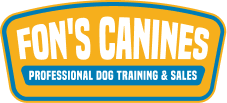
We have Trained Rottweiler Puppies for Sale at our San Diego Facility
Upon request all of our dogs will be trained in basic obedience, this means that your dog will be:
Trained in on and off-leash obedience
Have great day-to-day behaviors and manners
Be well socialized and custom to a variety of different social settings
Come with a Lifetime discount on boarding, daycare, bathing, dog food, and training!
All of our trained pups have been to a ton of places, have been worked by a variety of different people and
will absolutely be the best-behaved pet you’ve ever owned! We also do provide personal and family
protection dogs, service dogs and emotional support dogs too!
AKC Rottweiler Puppies for Sale
Ready to go home today!
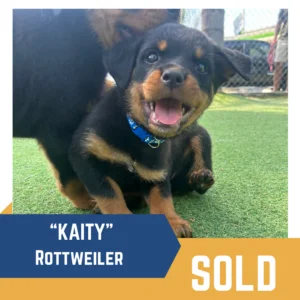
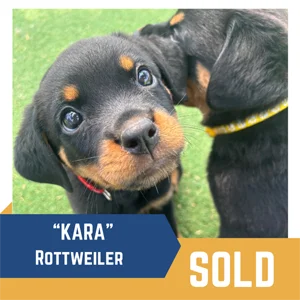
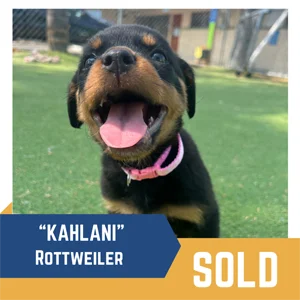
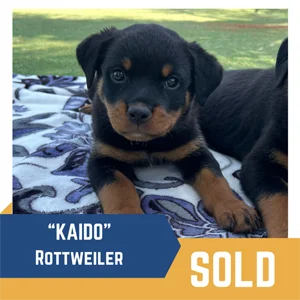
We care deeply about finding the best possible match for both our dogs and our clients. With that in mind, we take into consideration the home environment, living conditions, and lifestyle of each prospective owner. Our training director will assess which dogs are most suited for each client, ensuring the well-being of both the dog and their future family. We appreciate your understanding and look forward to the opportunity to work with you soon!
Fon's Dog Training Payment Policy for Pre-Trained Dogs and Puppies
Welcome to Fon’s Dog Training. To provide clarity and ensure a seamless purchasing experience, we have outlined our payment policy for pre-trained dogs and puppies below:
Any inquiry regarding the purchase of a pre-trained dog or puppy requires payment in full at the time of purchase. This policy guarantees that the dog you select will be reserved exclusively for you. Please note that payment must be submitted at the time of purchase to confirm your reservation. If payment is not received, the dog will remain available to the public and may be purchased by another party without prior notice.
Accepted Payment Methods: We accept cash, check, credit/debit card, wire transfer, and cashier’s check. For your convenience, a variety of payment options are available to meet your needs.
Payment Plan Options: For those interested in financing, please visit the “Fon’s Dog Training Payment Options” tab on our website to explore Coach Financing and determine your eligibility.
Thank you for your cooperation in adhering to our payment policy. Should you have any questions or require further assistance, feel free to contact us. We are here to help you find your ideal companion and ensure a positive experience throughout the process.
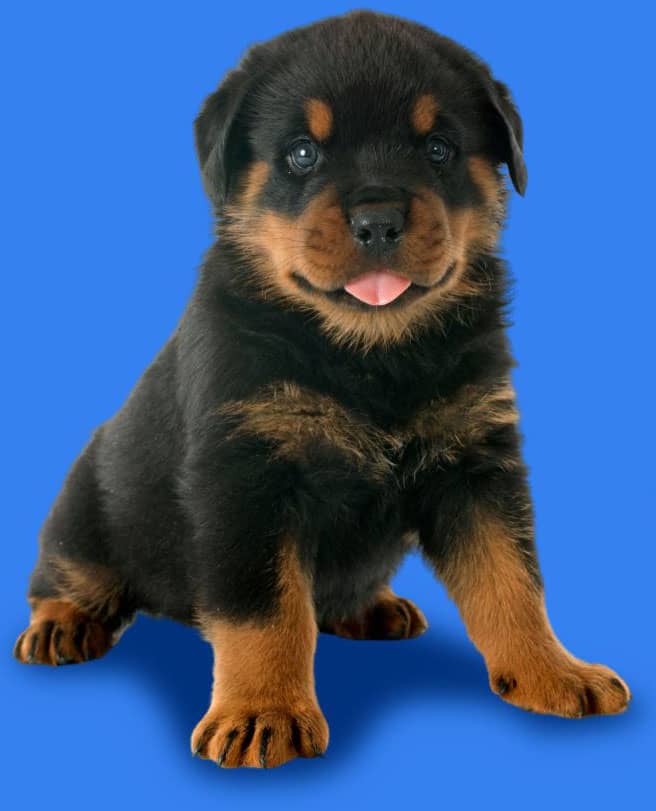
More puppies Coming Soon!
Spring 2025
Our Testimonials
Rottweiler Puppies We Have Sold
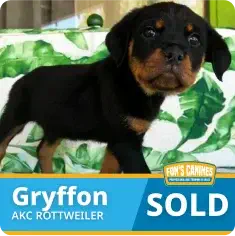
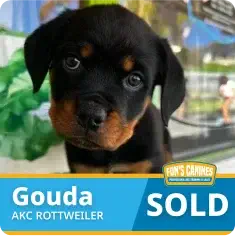
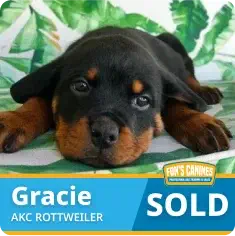
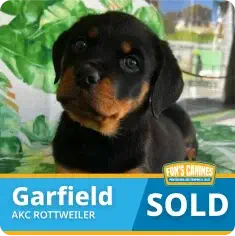
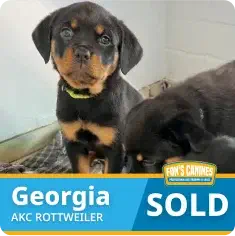
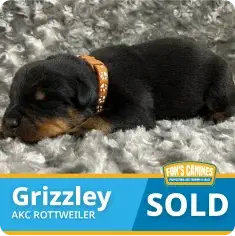
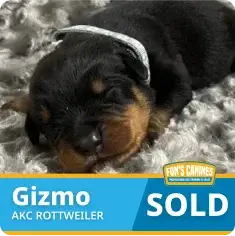

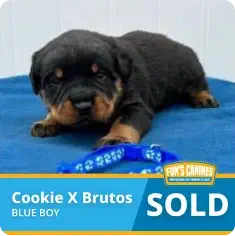


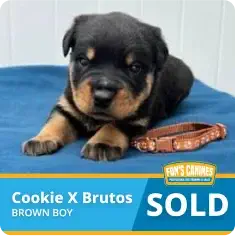


Rottweiler...
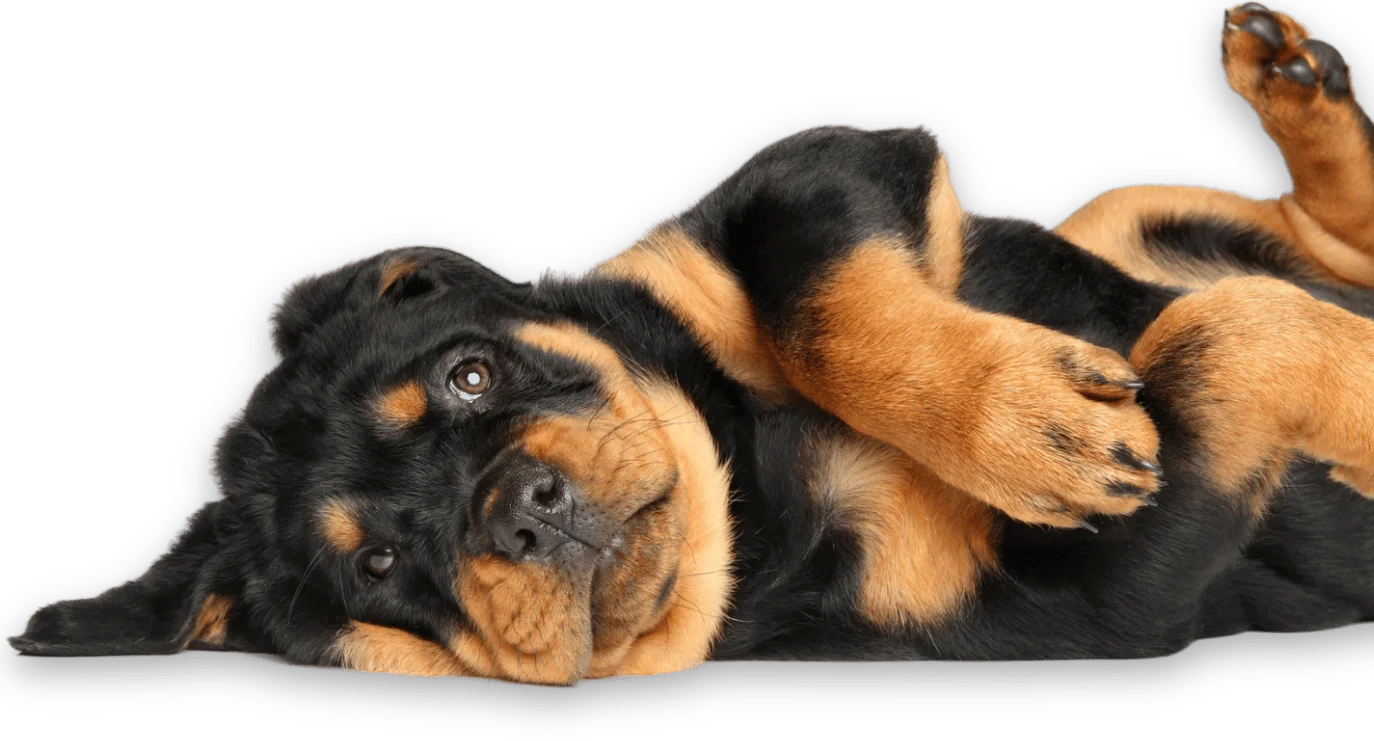
Breed Summary
Rottweiler Origins
The Rottweiler is a breed of antiquity with roots that go back to the ancient Roman army dogs. Long before the MRE (Meal, Ready-to-Eat) or refrigeration, large armies would bring along their own living food sources to feed the hungry soldiers while on an excursion. Large, durable Mastiff-type dogs were employed to drive, herd, and protect the livestock. As the armies continued and the food source would dwindle, the dogs would be left behind. As the empire fanned out, they covered much of Europe. Around A.D. 74, the main passage over the Alps was Gotthard’s Pass, which leads into modern-day southern Germany. Due to this likely route, it is believed that these dogs also influenced many Swiss mountain breeds, such as the Swiss mountain and cattle dogs. Once over the Alps, the armies infiltrated the German town of Rottweil. There, many of these dogs were left and utilized by the Roman army as well as locals for the next 200 years. The town of Rottweil became known as the European cattle epicenter and remained so over the next 1800 years. There, the large dogs assisted cattle herdsmen and butchers and became known as the Rottweil Metzgerhunds, or “butcher’s dogs.” They were employed to guard, herd, and drive cattle, as well as pull carts of meat and milk to market. To ensure the safety of their earnings upon the dogs’ return, the butchers would tie the money around their dogs’ necks in the event someone would try to rob them.
Over time, long after the Roman armies left, progress began to change the European cattle industry. As the train robbed the Rottweiler’s ancestors of their primary purpose, their numbers began to decline. In fact, the numbers dwindled so dramatically that only one Rottweiler was entered into the 1882 Heilbronn dog show. It wasn’t until World War I that the breed’s numbers and demand returned. The need for strong, intelligent working dogs for police and military led to the revival of the Rottweil dogs. The Rottweiler, like his ancestors, found himself serving his country once more as a messenger, draft dog, guard dog, and ambulatory dog through the first and second World Wars.
Despite his service and utility, it wasn’t until 1914 that the first Rottweiler club, the Deutscher Rottweiler Klub (DRK) was established. In 1921, the Allgemeiner Deutscher Rottweiler Klub (ADRK) was formed from several other organizations. Today, the ADRK is recognized as the officiating club of the German Rottweiler breed.
The Rottweiler dog has become an international favorite. His popularity peaked in the mid-1990s, and the breed remains one of the most popular and easily recognized dog breeds today. The modern Rottweilers are still used as guard dogs, but they are also used as police dogs and therapy dogs. Today, the breed is renowned across the world for its intelligence and trainability.
Rottweiler Breed Characteristics
Rottweiler Head:
Mesaticephalic skull type, moderately large in size, and in proportion to the rest of the body. The head is heavily boned with powerful muscle throughout, giving the head and face height, depth, and breadth. The temporal muscles are powerfully-developed, giving the topskull height and a broad, flattened plane when viewed from the front. The zygomatic arches are broad and well-developed. The topskull is as long (from occiput to stop) as it is wide (measured from one side to the other right in front of the ears). The topskull is arched in profile, with the brow and stop being well-developed. A clean, dry head without excess wrinkle is preferred; however, slight wrinkling when the dog is alert is permissible. The occipital bone is well-developed, but not obvious.
Rottweiler Ears:
Medium in size, set high and wide apart on the corners of the skull, with the base level with the plane of the skull when at attention. They are drop, or pendant (not pendulous), and triangular in shape, with a broad base and rounded tip. The inner edge and tip should lie as close to the head as possible. They should not extend beyond the mid-cheek area. The ears are never long, overly large, fly-away, rose or semi-pricked.
Rottweiler Eyes:
Moderate in size, oval to almond in shape, and medium to dark brown. Their eyes may be slightly obliquely set. The eye rims are well-fitted and well-pigmented. The eyes are never rounded or bulging. There should be sufficient bone in the surrounding orbital sockets to protect the eyes. Any signs of entropion or ectropion are incorrect for this breed.
Rottweiler Muzzle:
The muzzle is full, deep, and broad. The plane, or bridge of the muzzle, is straight. Upper and lower jaws have good bone substance, appearing strong and well-developed, never appearing snipy or weak.
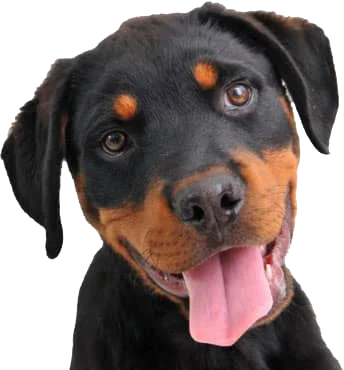
Rottweiler Nose:
The nose is well-pigmented and black. The nostrils are well-opened.
Rottweiler Neck:
Relatively thick to denote strength and power. Sufficient length to allow for proud head carriage and powerfully muscled with a slight arch. The neck tapers slightly from the deeper and broader body toward the head. The neck is clean-cut and without excess skin, throatiness, or dewlap.
Rottweiler Chest:
Moderate length to allow for proud head carriage, strongly muscled with a slight arch. The neck tapers smoothly from the deeper and broader body toward the head. The neck is clean-cut, without excess skin, throatiness, or dewlap.
Rottweiler Body:
Compact, solid, powerful, agile, and of good substance. The body is never racy or refined. Width at the forequarters is approximately equal to the width at the hindquarters.
Rottweiler Feet:
Oval to round, compact, with well-arched toes and tough pads.
Rottweiler Feet:
The Rottweiler’s movement is powerful, effortless, and efficient. It should indicate endurance and agility. Excessive roll or clumsy action is to be heavily penalized. The characteristics of a healthy structure are evident: when moving away, the forelegs and rear pasterns should remain parallel to one another. When viewing movement from the front, the forelegs should remain parallel, with elbows and paws moving neither in nor out. From the rear, the back pads should be visible when the rear legs are extended. As speed increases, the forelimbs and hindlimbs will converge to the center line of gravity. From the side, the topline should remain firm and level. Good reach of movement in the front allows the forepaw to extend out in line with the nose. The width between the forefeet, when extended, should be approximately equal to the width between the hindfeet when extended, indicating balance, good reach, and good drive. Dogs that exhibit any sign of breathing or locomotive difficulty shall be disqualified from the show ring
Rottweiler Tail:
Set neither high nor low on the croup but as a natural extension of the topline. It is thick at the base and tapering toward the tip. The tail is carried in accordance with the dog’s mood and energy level but never tucked. When in repose, the tail may be carried low (never tucked) in a neutral position. When moving, it should be carried slightly above the level of the topline. The tail may be left natural (preferred) or docked short. Natural tails are of a medium length, with the tip of the last vertebrae extending to the hock joints when held down. Natural tails may be straight, gently curved, sabered, or sickled. Docked tails are cut short to one vertebra.
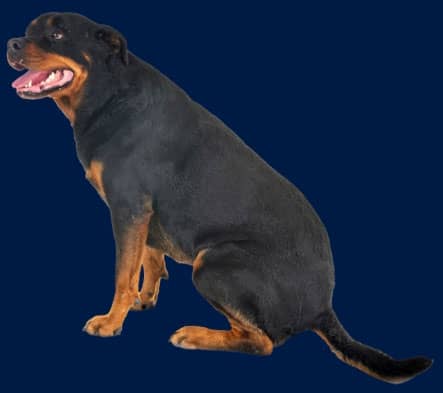
Rottweiler Temperament:
The Rottweiler is a devoted companion and working dog. The breed is generally known to be even-tempered, watchful, and extremely intelligent. This makes Rottweilers great family dogs, useful in nearly any task. They are keenly watchful of their family and property. However, any unprovoked aggressive or fearful behavior toward people is incorrect for this breed.
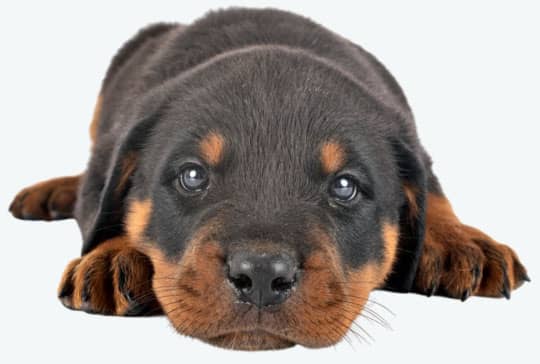
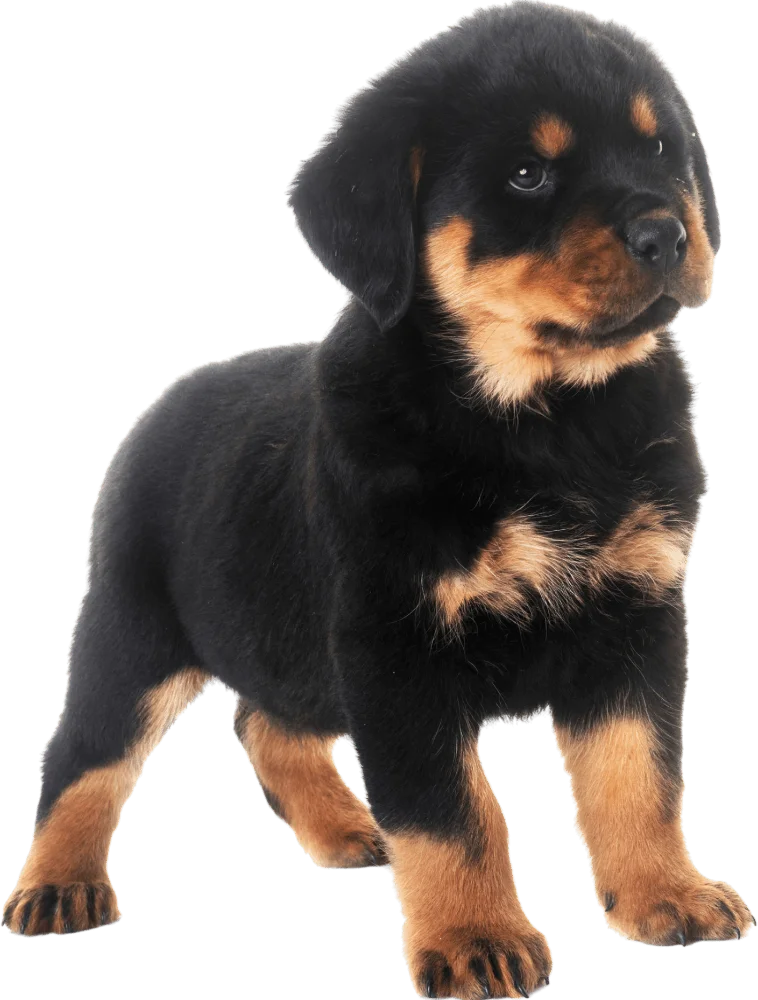
About Rottweilers
A Rottweiler is a medium to large dog. Just remember, that cute little puppy will grow into an adult that is about 22 to 27 inches high with an average weight of between 90 to 135 pounds. That’s a lot of dog, and most of it is muscle. The Rottweiler possesses great strength and has a broad, deep chest. It lives for about 10 to 12 years.
Rottweilers have short, coarse hair and should be brushed about twice a week. Brushing encourages the growth of new, healthy hair and removes older hair that is ready to shed. Brushing also allows you to bond with your Rottweiler. Beginning this regimen while your pet is a puppy is an excellent way to begin a close, trusting relationship.
Rottweilers are prone to obesity. It is important that your Rottweiler gets enough exercise and eats a healthy diet.
The Rottweiler is an intelligent dog. They are strong, powerful, and fearless, making them good watchdogs. The Rottweiler is an extremely loyal dog and will instinctively guard his family and territory.
With the right training, the Rottweiler is a wonderful companion. But without continued socialization, companionship, supervision, and obedience training a Rottweiler can be too much dog for many households.
The breed is considered a working dog and guardian, and it is believed to be a descendant of the herding drover dogs of the ancient Romans. This is a breed that needs a job to be happy. They do well as police dogs and therapy dogs. You have to keep a Rottweiler entertained with physical activities, especially walks, exercise, and outdoor activity. Without these needed distractions, a bored Rottweiler may become destructive.
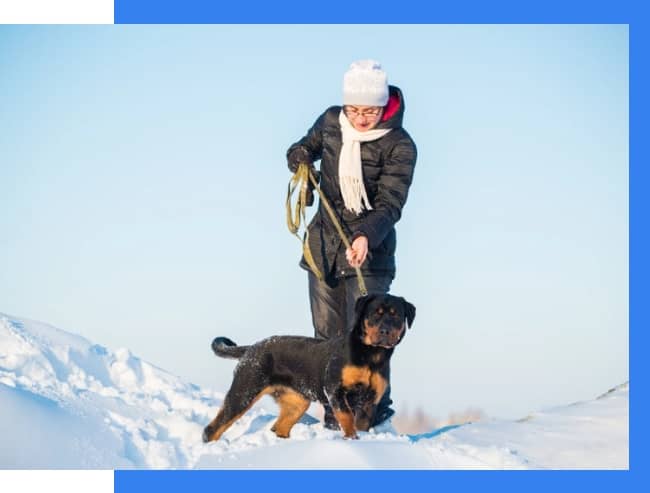
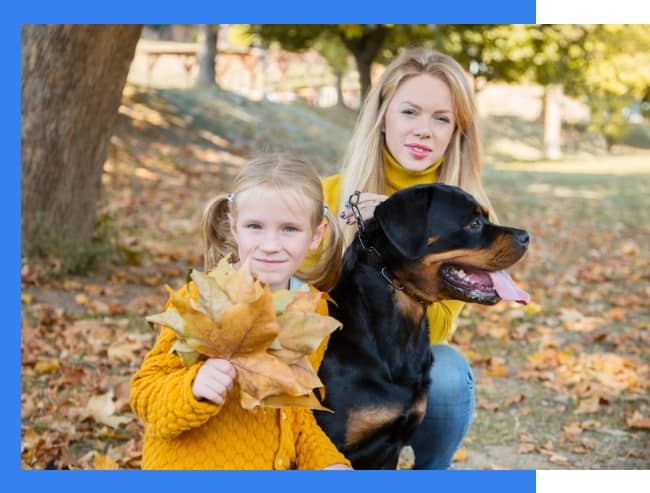
With Rottweilers it is important to remember that they need extensive and continuous socialization to be good family companions. Training should start as a puppy, as early as six weeks of age.
Rottweilers have a reputation for being a dangerous dog, but this dog will only become vicious if it is trained to be that way. Still, certain regions have passed legislation banning this breed; so make sure to check for local regulations before you purchase a Rottweiler. In addition to legal regulations, you may also have trouble getting renting a home or getting a homeowners insurance policy if you own a Rottweiler.
Owning A Rottweiler
Raising a Rottweiler from a puppy allows you to train and socialize him. If a Rottweiler puppy is raised with children, friends and other pets it is more likely that he will become a well-socialized dog.
It is important that you commit to training your Rottweiler and that you be very consistent. Most Rottweilers are inclined to be dominant but they will respect an assertive owner who knows how to lead a strong-minded dog. You’ll need to teach your Rottweiler puppy social skills and to harness his natural territorial instincts in a positive way.
Young Rottweilers can be very rambunctious. They are rowdy and enthusiastic jumpers. Unsupervised, they can become nuisance barkers and diggers.
If a young Rottweiler is raised with other pets in the home, they are usually good with them, but Rottweilers can be very aggressive toward other dogs of the same sex – and they can see cats as prey.
A Rottweiler may not be a good choice for first-time dog owners. If you are fully committed to training and socializing your Rottweiler puppy, it can become a very loyal and loving companion and a great family pet.
Owning a Rottweiler requires a commitment to training and socialization, so make sure that you are prepared to put in the required effort.
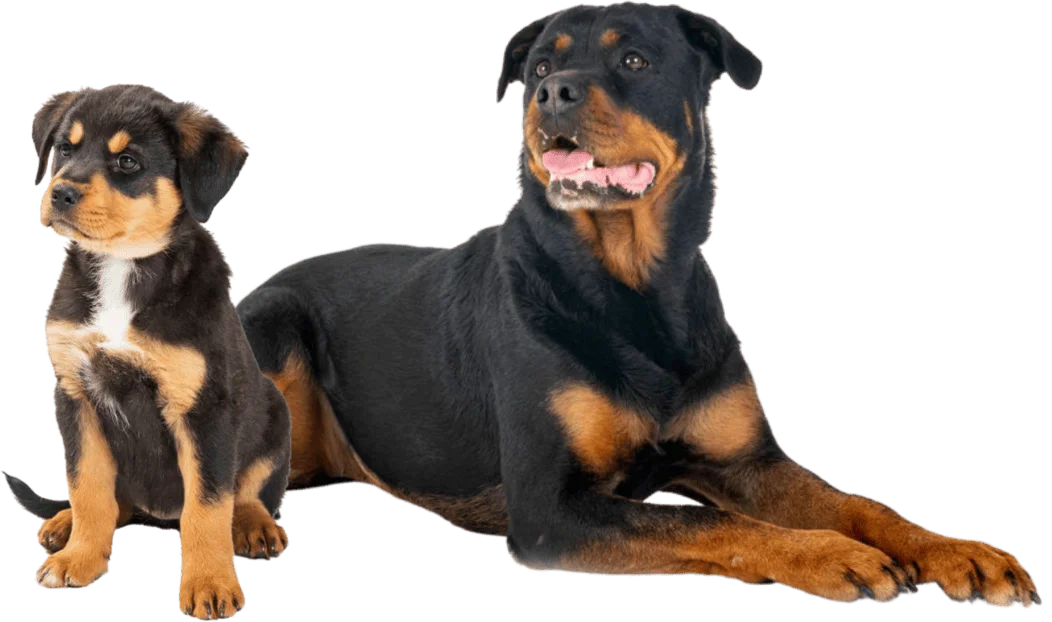
Frequently Asked Questions
Where do they come from?
We breed our Rottweilers in house!
Have the parents health / hips been checked?
Yes, we have full health clearances on all of our dogs for sale!
Are they trained?
Our puppies do not come trained, but we do offer life time discounts on dog training once the puppies are 14 weeks old!
Are Rottweilers good with kids and other pets?
Rottweilers are great family dogs! As long as they are properly trained and socialized, they are some of the best dogs to have!
How big will my Rottweiler puppy get?
Male Rottweilers typically weigh between 95 and 135 pounds and stand about 24-27 inches tall at the shoulder. Females typically weigh between 80 and 100 pounds and stand about 22-25 inches tall.
What health problems are Rottweilers prone to?
Some common health issues in Rottweilers include hip and elbow dysplasia, heart conditions like aortic stenosis, certain types of cancer, and eye problems. Buying from a reputable breeder who health tests their dogs can help reduce the risk of these issues.
What should I feed my Rottweiler puppy?
We feed all of our dogs Inukshuk Professional Dog Food, imported directly from the manufacturer in Canada.
Can we meet the parents?
YES!
Are they German or American?
They are German Rottweilers
How much does a Rottweiler puppy cost?
Our puppies are $2500 plus tax!
Are Rottweilers easy to train?
Rottweilers are intelligent and great dogs to join your pack. Generally speaking, they love food and pets, which makes them great dogs to train! Because of their size and strength, it is important to start training them early and being consistent! the longer you wait to train them, the more bad habits are created. The more bad habits they have as they get older, the more difficult it is to break them! It is ideal to start training your Rottweiler puppy as soon as possible, as early as 16 weeks old!
How much exercise does a Rottweiler need?
Rottweilers are fairly active dogs that require regular physical and mental stimulation. We recommend 15 minutes of obedience a day to stimulate them mentally and get a nice stroll in!
Are Rottweilers aggressive?
Rottweilers are not inherently aggressive. They are naturally protective of their home and families as they were bred in Ancient Rome to protect the families and carts from robbers, and cattle and livestock at home. Any dog, regardless of breed, can show aggressive tendencies without the right training and socialization.
How long do Rottweilers live?
The average lifespan of a Rottweiler is around 8-10 years. However, some can live longer with proper care, regular vet checkups, and a healthy diet.
Visit Our Dogs
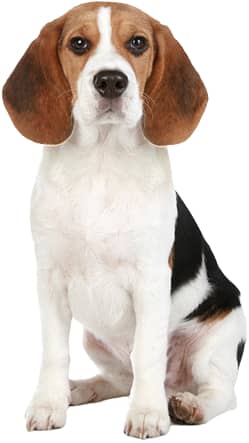
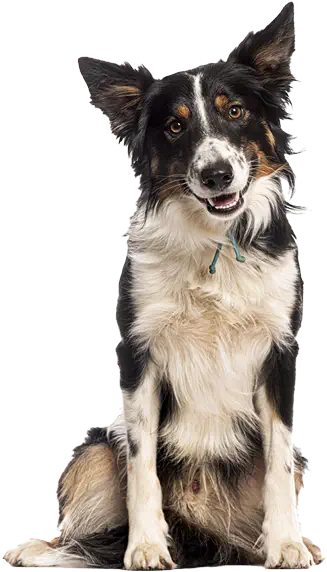
San Diego Zip Codes Where We Offer Dog Training
91911
92154
92592
91910
92115
91977
92020
91950
92117
92111
92024
92129
91913
92026
92064
92127
92122
92040
92102
92078
92054
92037
92083
92065
91915
92058
92124
91941
92107
92110
92173
92008
92067
92136
92003
91906
91916
92059
92086
92152
Click to See More Zip Codes
92071
92130
92057
92027
92011
92014
91903
91908
91909
91912
91921
91933
91943
91944
91947
92084
92028
92056
92025
91902
91978
91946
91948
91951
91976
91980
91979
91990
91987
92013
92069
92128
92109
92104
92082
92075
92018
92022
92023
92030
92033
92038
92039
92046
92052
92009
92019
92101
91942
92118
91914
92051
92068
92074
92072
92079
92085
92088
92090
92093
92672
92139
92131
92103
92106
92007
92092
92096
92112
92133
92135
92138
92137
92143
92142
92123
92116
92081
92120
92055
91935
92150
92149
92153
92159
92161
92160
92163
92162
92165
91932
91945
92108
92029
91901
92121
92164
92167
92166
92169
92168
92171
92170
92172
92175
92004
92036
91962
92140
91917
92061
92177
92174
92176
92179
92178
92184
92187
92186
92191
92091
91905
92182
91963
92070
92145
92190
92193
92192
92195
92194
92197
92196
92199
92198
Click To See The Neighborhoods Where We Offer Dog Training
North County Dog Training
Carlsbad
Adobe Hills
Alga Hills
Alicante Hills
Arterro
Aviara
Barrington Place
Calavera Hills
Carlsbad East
Carlsbad South
Carlsbad West
Castlemar
Cortez
Fairway South
Flave La Costa
Jerez Court
Jockey Club
La Costa
La Costa Downs
La Costa Fairways
La Costa Greens
La Costa Heights
La Costa Knolls
La Costa Meadows
La Costa Oaks
La Costa Oceanview Estates
La Costa Ridge
La Costa Valley
Lakeshore Gardens
Meadowood
Mehr Villas
Monarch Villas
Morning Ridge
Olde Carlsbad
Omni La Costa Resort
Rancho Carrillo
Rancho La Costa
Santa Fe Trails
Sea Point Tennis Club
Sonata
Southern Preserve
Stoneridge at La Costa Oaks
Summerwalk
The Foothills
The Ranch
Villas of La Costa
Viridian
Encinitas Dog Training
Avocado Acres
Beach
Beachwalk
Beacon Beach Village
Bello Mar Estates
Cambria
Cantebria
Cardiff By The Sea
Coast Country
Colony Highlands
Copper Crest
Country Rose
Crest Acres
Crest Drive
Devonshire
Double LL Ranch
Dove Hollow
Encinitas
Encinitas Coastal
Encinitas Estates
Encinitas Highlands
Encinitas Hills
Encinitas Ranch
Fiore
Flair
Forrest Bluff
Green Valley Estates
Haciendas De La Playa
High Country Villas
Hillside Acres
Knightsbridge
Lake Val Sereno
Leucadia
Leucadia Acres
Leucadia Beaches
Leucadia Collection
Mainhouse
Maravu
Mendocino
Monte Mira
Moonlight Beach
Morning Sun Ranch
Neptune
New Villanitas
Normandy Hill
North Leucadia
Sage Canyon
San Elijo Ranch
Sandalwood
Sandpiper Point
Saxony
Seabluffe
Seagate Village
Seaside Gardens
Seaside Ridge
Sidonia
Sienna Canyon
Sky Loft Clusters
South Coast Park
Summerhill
Summit at Cantebria
The Sands
The Terraces at Cantebria
Vida Pacifica
Village Creek
Village Park
Villanitas
Wildflower Estates
Sage Canyon
San Elijo Ranch
Sandalwood
Sandpiper Point
Saxony
Seabluffe
Seagate Village
Seaside Gardens
Seaside Ridge
Sidonia
Sienna Canyon
Sky Loft Clusters
South Coast Park
Summerhill
Summit at Cantebria
The Sands
The Terraces at Cantebria
Vida Pacifica
Village Creek
Village Park
Villanitas
Wildflower Estates
Carmel Valley Dog Training
Miramonte
Del Mar Heights
North City
Del Mar Mesa
Pelacio Del Mar
Cielo Del Mar
Pacific Beach Dog Training
North Pacific Beach
South Pacific Beach
Mount Soledad
Central Mission Beach
Belmont Park
Crown Point
Central & Costal Dog Training
Hillcrest
Little Italy
Gaslamp Quarter
East Village
Mission Hills Dog Training
Devonwood Park-West
Expressions
Mission Hills Brand
Mission Hills Cedros-San Jose
North Mission Hills
Orion
Upper San Jose St
Ocean Beach Dog Training
North Ocean Beach
South Ocean Beach
The Hill
Point Loma
Coronado
Bankers Hill Dog Training
Park West
Florence Heights
La Jolla Dog Training
La Jolla Farms
La Jolla Shores
La Jolla Heights
Hidden Valley
Country Club
Village
Beach-Barber Tract
Lower Hermosa
La Jolla Mesa
La Jolla Alta
Soledad South
Muirlands West
Upper Hermosa
La Jolla Village
Inland Dog Training
Alessandro
Amtrak
Arrowhead
Arrowview
Belevedere
Blair Park
Cajon
California
Carousel
Carvedale
Cimmeron
Curtis
Delman
DMV
Drnag
East Valley
Feldheym
Hi-30
Hudson
International
Kendall
La Plaza
Lankershim
Lytle Creek
Mount Vernon
Muscoy
Muscupiabe
Ne-Sterling
Nena
North Park
Pacific
Perris Hills
Rancho West
Ridgeline
Riverview
Roosevelt
San Gorgonio
Sandin Hills
Sbhs
Seccombe Lane
Show Place
South Pointe
Stadium West
Terrace
University
Valley College
Valley View
Wildwood Park
Wilson
Yerdemont
Normal Heights
North Park
South Park
Our San Diego Location
Send us a message
Directions to Fon’s Canines Dog Training from Common Places in San Diego
San Diego International Airport to Fon’s Canines Dog Training – San Diego Dog Training
3225 N Harbor Dr, San Diego, CA 92101
Get on I-5 N from N Harbor Dr and India St
9 min (3.4 mi)
Follow I-5 N to Garnet Ave. Take exit 23B from I-5 N
5 min (5.2 mi)
Drive to Santa Fe St
3 min (1.1 mi)
Destination:
5050 Santa Fe St Suite B, San Diego, CA 92109
Downtown San Diego to Fon’s Canines Dog Training – San Diego Dog Training
Get on I-5 N
3 min (0.8 mi)
Follow I-5 N to Garnet Ave. Take exit 23B from I-5 N
6 min (6.7 mi)
Drive to Santa Fe St
3 min (1.1 mi)
Destination:
5050 Santa Fe St Suite B, San Diego, CA 92109
La Jolla to Fon’s Canines Dog Training – San Diego Dog Training
Take Fay Ave and Girard Ave to Torrey Pines Rd – 3 min (0.7 mi)
Continue on Torrey Pines Rd. Take La Jolla Pkwy and I-5 S to Damon Ave – 8 min (5.1 mi)
Follow Damon Ave and Santa Fe St to your destination – 2 min (0.5 mi)
Destination:
5050 Santa Fe St Suite B, San Diego, CA 92109
Send us a message
